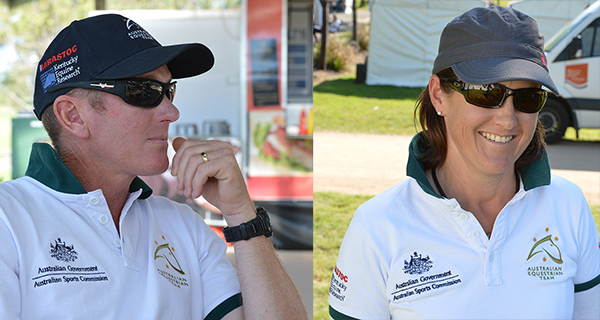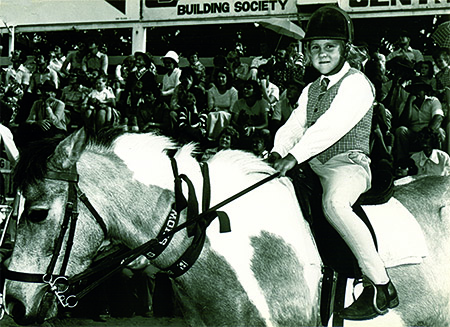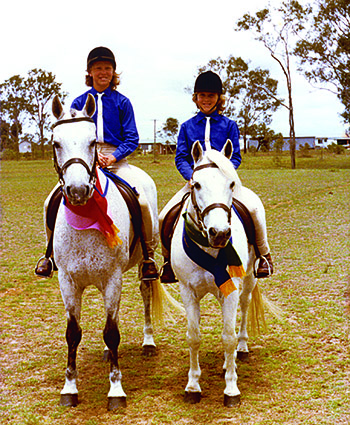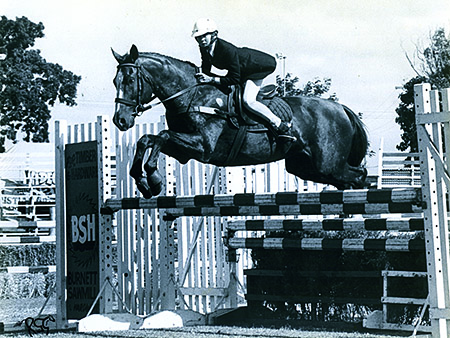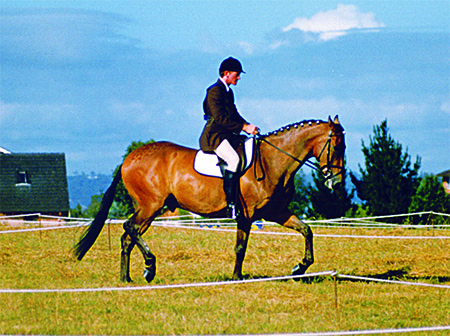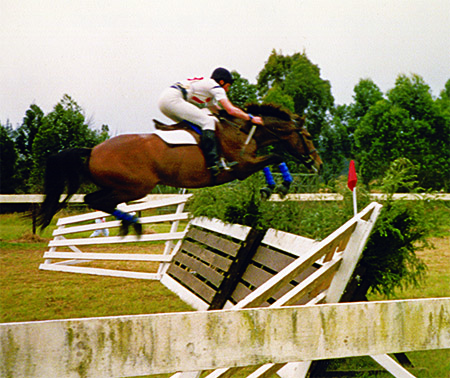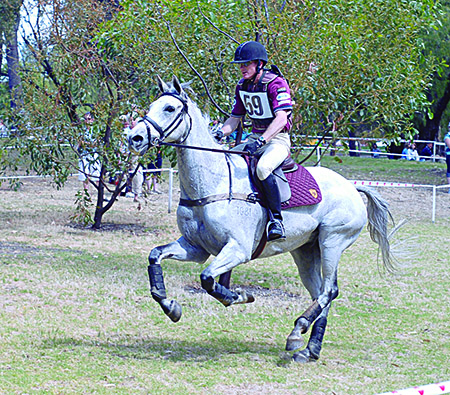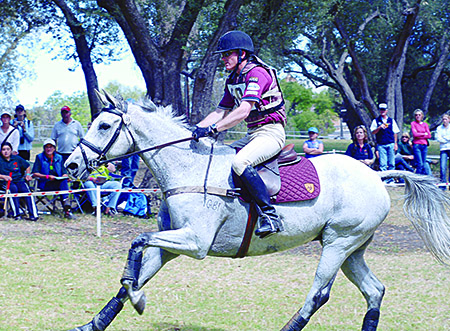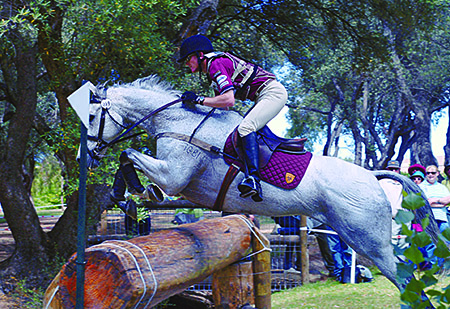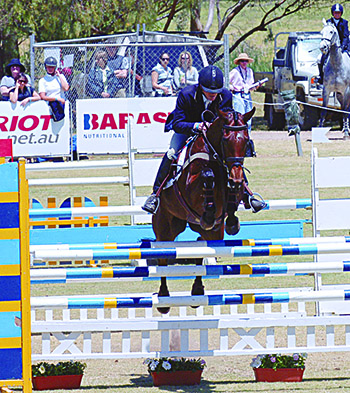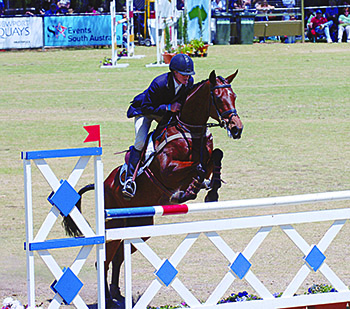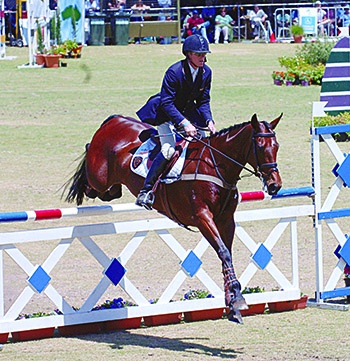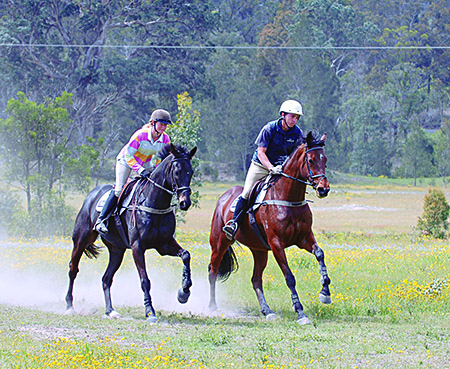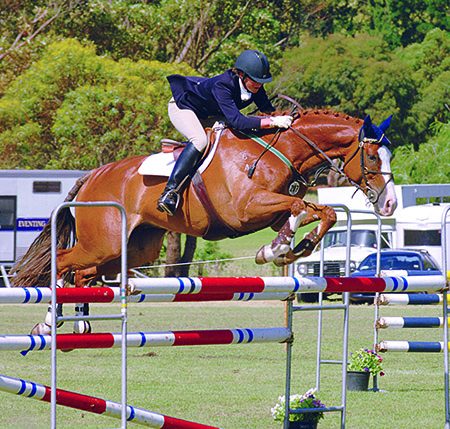Meet Prue and Craig Barrett and plug into their Eventing Encyclopaedia!
Story – Chris Hector & Photos – Roz Neave
Craig and Prue Barrett are only in their early 30s but already between them they have acquired an encyclopaedic knowledge of the sport of eventing: as front line competitors, as students themselves, and more recently as coaches and mentors to an increasing number of talented students.
Craig and Prue graduated from the University of Eventing, the NSW Equestrian Centre, where they learnt much from Professor Heath Ryan – and for that matter, head of dressage studies, Emeritus Professor Rozzie Ryan, as well as sharing the buzz with an unusually talented bunch of fellow students.
For Prue Cribb as she was then, the caldron at Lochinvar was just another step on a horse career that had more or less started in the cradle:
Look at that jaw – she was always headed for the top! Prue at the age of seven on Peter Pan
“My mother Jennifer bred horses. Mum was quite passionate about breeding and competing. Originally she was breeding horses for us to ride, we all rode as children. Mum would have us breaking in during the school holidays – she would probably have five to ten foals born each year. That was our summer holidays, breaking in ponies. It was pretty wild.”
The Cribb sisters starting out on their illustrious career – 12 year old Felicity is left, on Bronka and 9 year old Prue is on Scott.
“She had Connemaras to start with and she thought she was going to breed 15.3/16 hand Connemaras, but it didn’t work – they never grew.”
“Then she bred a couple of Warmbloods. Cadenza that Lea Bierman rode Grand Prix Dressage on, was one of the first she bred. She bred a couple by Heini, a stallion now down in Victoria.”
“She bred Carmody Street that my sister Felicity rode at the 1994 WEG. He was stock horse. She found a Stock Horse stallion, Harry Lime, that came from Alan Williams who bred a lot of jumping horses up in Northern Queensland. Mum had sold his mother ponies in the past, so there was a connection there. Alan had showjumped Harry Lime, and Mum bred quite a few of them.”
Twelve year old Prue jumping the stallion, Harry Lime – sire of Carmody Street
She must have been a bit before her time?
“Totally. And probably in the wrong part of the country too… We grew up in Bundaberg in Queensland. She mainly showjumped herself, she jumped at Sydney Show. She had some quite good horses. I think she showjumped because that was the thing to do in those days, but she was more keen on the eventing. She didn’t really want us to showjump – we did a little – but she was keen for us to event.”
It was not only horses – your mother bred two international event riders – you and your sister, Felicity?
“Well yes. She encouraged us to ride and she encouraged us to ride well, and she wanted us to be serious about it. But I don’t think she really was that keen on us taking it on as a full-time profession, but I guess she didn’t count on the fact of us going down to Heath and Rozzie at the NSW Centre, and actually having an avenue there to a career. She was probably a fairly hard task master… she never taught us as such, she said that was a recipe for disaster, teaching your own children, but she definitely managed us very well.”
Whereas Craig’s parents did not have Mrs Cribb’s knowledge and experience?
“No-where near it. My parents were not horsey at all. We came from Sydney. Bought our first horse when I was ten – the Pony Club day meant that Dad put the trailer on the car, Mum would organize the picnic, and we would all hope that the horses would go on the float because if they didn’t then we didn’t get there. We’d pull up at the Pony Club, they’d have some lunch and we’d bolt around, and it was time to go home. So it was nothing like the background that Prue had.”
Setting out – Craig and Bunyip of Coolalee…
“Still I got access to Heath Ryan’s information probably at an early enough age, just! I was probably fifteen when I got lucky because my father decided we needed another horse, and we went to one of the first auctions at the NSW Equestrian Centre, and Dad bought Bunyip of Coolalee. Six weeks broken in! Crazy, what were we doing? $1700, I think he was – really expensive. The horse happened to belong to Mr and Mrs Ryan, and Matt was riding it in the auction. I went out the back and met Matt – because I hadn’t tried the horse of course! I was looking at my Dad going what are you doing? So I went and met Mr and Mrs Ryan and met Matt, took the horse home. I was supposed to go to Matt’s for work experience, but he was too busy, so he said, here ring my brother, Heath, at the Centre.”
Craig and Bunyip – and the horse’s first steeplechase. “Thank goodness we don’t have that any more!” comments the rider…
Craig on: Three shades of contact: A challenge for the eventing rider
Traditionally Australians have been good at cross country with bold galloping horses, we have a tradition of fast bush riding… Eventing riders are very happy with that contact, where you have the horse up in your hand and going and wanting to go fast. Australians are very happy with a horse being fiery; we grew up with the Australian Thoroughbred. That’s something that comes through a lot of the cross country riding in Australia. So that is one sort of contact, and it is great for cross country.”
“But then we have change from that strong cross country contact to a contact that is suitable for dressage and then to another contact for showjumping. The three of them are all very different.”
“Dressage has to be more of a subtle, softer contact, where the horse is responsive yet submissive throughout its body – and getting that good contact is what usually lets you down in your dressage test. If the contact is a bit rigid or a bit light, and the horse is not quite happy, then that is going to come out in an inconsistent head carriage. The judge starts to be able to spot what you are trying to hide. For dressage, the contact has to be more subtle in your hand.”
“If your horse leans down in the cross country, like a lot of Thoroughbreds want to do, and that contact transfers to your dressage, you then struggle with balancing and engaging the horse, getting the horse off the forehand, getting the poll up.”
“A lot of the problems associated with bad dressage marks, come from the situation where riders are happy with the horse going too much forward into their hand and that comes from the cross country. As eventers, we are quite happy with that contact. We don’t think that is a problem – put a dressage rider on, and they wouldn’t be happy, they’d say ‘we better fix this!’ It’s obvious to the dressage rider that there is a contact problem, but to the eventer, that’s how we ride, that’s how we go, that’s how we gallop. We go fast, the horse leaning down a bit heavy, or taking a hold in the hand, fine, that’s how you need your horse to go cross country.”
“A lot of our riders, especially the guys, when they go to train dressage and they feel they have to put the horse together, then as a guy, you straight away will use your strength to do that. As soon as you start to use your strength then your muscles tense up and if you are trying to stay in the saddle by using your strength and because your muscles are tense then you are likely to bounce out of the saddle.”
“You can’t use your strength when you are trying to ride – it again comes out in the horse not accepting the contact because the guys are trying to use their strength to stay with the horse’s motion, or keep a contact on the reins. But you’ll see when they point themselves at a jump, they are able to travel on a much lighter contact and hop off the horse’s back, so they don’t actually have to be with the horse in a dressage sense – then they look comfortable again after looking so uncomfortable in the dressage. That leads us to the jumping contact…”
“Again, I’m no expert in showjumping, but the feeling is when you ride showjumping the horse has to be a little more up in front, a little higher in his poll, a little more nose in front of the vertical – but still travelling in a very balanced fashion. Still like the dressage, it can’t be dragging you forward into the contact. We get away with that on the cross country because there’s only 25 to 30 fences around a six kilometre cross country course and the rest of it is galloping.”
“We’re galloping and the horse has to go down to take the bit and we have to go fast. Showjumping, if that horse starts to get into a let’s go faster, let’s go longer attitude, then these days with the lighter gear and the more technical courses, then you’ll get into trouble. If the horse starts to lean on your hand, and the contact starts to get heavy, that’s when you have rails down.”
Craig and Tarranlea Eloise in the CCI* at Adelaide – a different sort of contact
“I think you’ll find that’s why the showjumpers will experiment with a lot of different bits until they get the contact right and they are happy with the control they have – because if that isn’t right, then they know they are going to get dragged through a fence, and have a rail. But as eventers, we don’t register that as being a huge problem, we are quite happy with the horse taking us to the fence because on the cross country, when you are going to a big ditch and brush and it is seriously scary, you need that horse to have hold of the bit. You’ll want it telling you that it is going to go, and you’ll feel that through its mouth. That’s the first place you’ll feel it – if the horse is going to go, it will have the bit between its teeth and be taking you.”
“Now if you try to take that cross country contact into the showjumping ring, you are going to knock a lot of showjumping rails down – in showjumping the horse has to be not so aggressive, the contact has to be lighter, the contact has to be more responsive – so if you say steady or whoa or wait, the horse is going to respond.”
“That’s the classic example: when we ride to a fence and the horse is a bit strong and grabs the bit and knocks the rail down, the showjumping coach goes ‘oh my goodness, that was terrible!’ And we go, ‘why?’ Well because it is not the contact that you are after. It’s not the balance you are after. And I think that is the difference between the three different sorts of contact.”
“The riders that you see that handle the different sorts of contact very well, tend to be mainly the girls – for example, Olivia Bunn combines the three very well, Sammi McLeod is another….
But cross country, Olivia tends to ride a little like a guy – she tends to be very deep in the saddle whereas a lot of the girls tend to float a bit above the saddle. Look at a photo of Bill Roycroft over a fence, then look at a photo of Olivia, it’s that same long upper thigh…
“That could be true, as a coach I would advocate that the girls stay very close to the horse because the further you are away from the horse, the closer you are to falling off. And the girls don’t have the strength of a Shane Rose to drag themselves back in the saddle. Stuart Tinney rides very close to the horse. You won’t often see a lot of air between his saddle and his seat, and he balances the horse very well for the showjumping. But he is showjumping orientated, he trained with Wayne and Vicki Roycroft, so his basis is that showjumping way of riding.”
When you think back to the really good Kiwi eventers – Todd, Nicholson, Tait, Jefferis – they all started out as showjumpers, and jumped Grand Prix…
“Absolutely. I think that is still an advantage today, because showjumping is playing such a vital role in the whole thing, you have to be very good in the showjumping. But there are no two ways about it, any flaw in your dressage at that level, will also be uncovered. All those top riders combine all three – Megan Jones does it beautifully, she’s one of the fastest cross country riders around, the dressage is very solid and the showjumping is technically very good – she has the horse go in a very good frame. You’ve got to remember in the showjumping, the horse does have to watch the top rail, the contact allows the horse to look at the fence. If the horse isn’t balanced and on a nice contact, then he is not going to be pricking his ears and looking at the top rail.”
George Sanna remarked to me recently that he felt a lot of the eventers got in trouble showjumping because they obsessed about the shape of the horse as if it was a flat exercise, and that they took the horse’s attention away from the fence – and that they would be much better off to forget about the frame and think about the canter and get the horse focussed on the fence…
“You do see that. We do tend to want the horse to go in a particular way – especially when you have the dressage training that you do for five days a week if you are an eventer. If you want to separate the two approaches: the dressage horses have to fall back on the rider, and they have to be waiting for the rider’s command to do the next movement, whereas the showjumping horse has to be watching the fence, rather than having their attention on the rider. The rider has to at some point, transfer the horse’s focus to the fence. They still have to have the horse disciplined. They still have to have the horse doing what it is told but at some stage the horse must trust the rider and focus on the fence. If they don’t do that, and they concentrate on the rider all the way to the fence, unless the horse is super careful, or the rider has done a perfect job, then they are not going to jump it clear. If there is more attention on the rider than the rail, then there is more chance of the rail coming down.”
“So George is right. We tend to do things to the horse too close to the fence.”
Out for a gallop on the track at Craig and Prue’s property, Sandhills. Working pupils Georgina Lloyd and Joshua Hardy…
We’ve talked about Australians naturally liking that strong feel in the hand to go cross country, but is that another technique that you’ve got to master? Are there some horses that don’t want to give you that nice ‘drawy’ feel?
“Absolutely. There are a lot of horses, especially the really good ones that you need to be clever with. We have to remember that nowadays as eventers we do need them as careful as the World Cup jumpers, they probably don’t need to jump metre sixty square oxers but they do have to be careful. That presents you with a problem; a lot of the horses that are that careful don’t necessarily start off as the world’s bravest. In your cross country training, you will actually teach the horse to grab the bit and draw to the fence.”
How do you teach that?
“You would over-ride a particular fence or over-ride an approach until the horse takes your hand and you feel the horse wants to go. That’s a very educated technique. It’s not just something that happens, because if it is not educated and you just over-ride, most people then drop the reins, and the more they do that, the more the horse backs up.”
“I was at a clinic once, teaching with Wayne Roycroft, and this girl was trying to jump into water. I couldn’t get this girl to jump into the water to save myself. I told her to give it a hit with a stick and go back there, and blah blah blah, come in faster, and kick and whip, and do all the traditional things. Wayne finished with the rider he was helping, and I said ‘mate can you come here and give me a bit of a hand? I can’t get this girl into the water.’ It wasn’t a big fence, just a log into water, and he said, ‘just tell her to come down the hill, not too quick but hold his mouth.’ Okay, that’s not the way most people would do it, but sure enough she came down, just gently pulling on his mouth… and went straight it.”
“What you’ve got to remember is that the horse’s natural reaction is usually the opposite to ours. When you put the halter on the foal for the first time, and say, ‘come this way’ – they go back the other way. You put the bit in the horse’s mouth, you put the rein on and say ‘turn left’ and it cocks its head to the right. The horse’s natural reactions are very much the opposite of what we would think they should do. So when you ride your horse to the fence, and you let go of the reins and you kick it really hard, over time that horse will learn to back up to adjust itself to jump the fence. If you come in with no leg and pulling on the mouth, the horse will actually learn that it has to go at a faster pace to negotiate that particular fence, so it will learn to rush at the fence. So that is why you teach the horse to grab the bit and hold it. You do that by using your leg and over-riding it a little bit until it tells you it wants to go faster.”
“Now the trick is that you don’t let it go faster. You ride it, ride it, ride it, telling it to go faster but then you actually say, ‘don’t go faster’ – you bottle all this energy up, and the horse is wanting to go, and that produces a stronger contact. Then in front of the fence, you just allow the rein and that all of a sudden opens up a valve where this energy draws forward, and it takes the bit and goes forward. If you do that in an educated fashion, then you will teach the horse to be quite bold BUT it’s not good for the showjumping.”
So what do we do – we’ve just had a perfect cross country round, he’s drawn to every fence like a lion, but how do we get him back and balanced and careful for the next day?
“For a start you are hoping your horse is naturally careful. And I think we have to be able to train them to go in a different fashion and by that, I mean it is a different ride. You are not bottling the horse up as much, you give it a much more even rhythm to go round the showjumping course. I think something Wayne has introduced, and I think they first tried it with Tic Toc at Barcelona when they brought him out after the trot up and they did showjumping exercises, changing the horse’s tack and letting him think about it.”
Claudia Graham and Blazing Chief in the showjumping at Camperdown – the warmup is everything!
“We don’t want to canter into the showjumping arena with the horse still thinking about what he did over the last three fences on the cross country. We don’t want him long and flat. You actually have to ride the horse for 20 minutes and get over the fact that they are tired and flat and get out there and into the job. Claudia Graham at Camperdown last year, she rode her horse for 45 minutes after the trot up because she knew she had to get him back, thinking more along the lines of a showjumper. Then she hopped off, and then she went and did her showjumping in the afternoon. But that horse came back to her, and was ready to jump in a showjumping fashion.”
“Riding your horse after the trot up, even if it is for just 20 minutes, even if it is just jumping a couple of little cross rails, and couple of bounces, one vertical, an oxer… as long as you are happy that the horse has come back and is now registering that you want him to jump in a different fashion, you want him to travel to the fence in a different balance, you want to assess whether your canter is back where you want it. Coming off the cross country, they are going to canter on a 16 foot stride, maybe even longer, and that’s how they are going to come out the next morning. You’ve got to get that back, shorter. You’ve got to change the horse from the galloping fashion to a more of a shorter canter, more up in front, lighter contact – not dragging you into the fence.”
At this point do you want to put something a little more severe in his mouth?
“If you have to. I’m not averse to changing the bits from cross country to showjumping. As long as you are happy with the way the horse travels in the showjumping, and if that entails a change of bit, then I would recommend that for a lot of riders. For the professionals, and the people who are competing at Advanced level, then you should have a different feel in the mouth for the showjumping, and if another bit is going to give you that, then it is probably worth a go. If you have gone round the cross country in a snaffle, even if he has been on a loose rein all the way round, he is still going to be in a flatter, longer, galloping frame. Now if you go into the showjumping, and you pick him up, and he is heavy in the snaffle, he is going to be hard to get back in that way of cantering that you want for the showjumping.”
“If the different bit helps, then try it, but you do have to have independent aids, independent seat, independent hands, so that the bit doesn’t then play a part in bad jumping. If you are not independent in your hands, then you’ll create more problems with a stronger bit. Whatever you’ve got in his mouth, you want to be able to leave the horse to travel free, and do good releases over the jumps…”
This story originally appeared in The Horse Magazine, in February 2007


